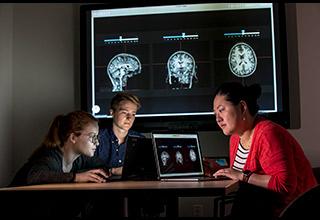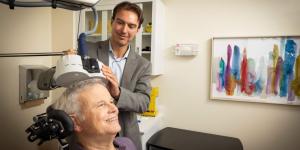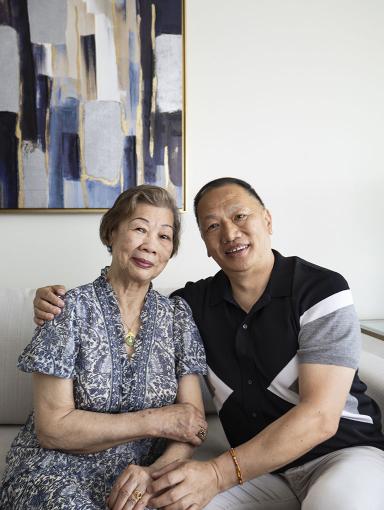At-Home Clinical Trials Are Making Research More Accessible
Learn about participating in research opportunities from your home.

Clinical trials are important to propel human health forward. They help researchers answer important questions about health and develop new treatments for people in need.
While clinical trials have traditionally been conducted in person in settings like medical centers, hospitals, and universities, technological advancements have triggered a recent shift toward at-home and remote clinical trials. In-person research will continue to play an important role, but medical researchers are also increasingly turning to at-home opportunities.
At-home clinical trials are on the rise
When COVID-19 began its worldwide spread in 2020, the resulting shutdowns impacted nearly every aspect of life. Clinical trials were no exception. By May 15, 2020, there was a 74% year-over-year decline in new-subject enrollment in clinical trials. Many clinical trials were disrupted or delayed altogether. Some, however, were able to adapt by using technology to measure the outcomes of trials remotely, in the comfort and isolation of the participant’s own homes.
“More and more trials have begun to monitor participants in their own homes. This shift started over a decade ago with the invention of smaller technology in the health care field and was then greatly accelerated by the COVID-19 pandemic,” says Brad Manor, Ph.D., the director of the Mobility and Falls Research Program at Hebrew SeniorLife’s Hinda and Arthur Marcus Institute for Aging Research.
“There are now low-cost and user-friendly sensors available to measure many different aspects of human physiology and behavior at home, from physical activity, to sleep, blood glucose levels, and beyond,” says Dr. Manor, who is also an associate professor of medicine at Harvard Medical School.
The value of home-based clinical trials
According to Dr. Manor, the traditional research method comes with limitations. For starters, in-person clinical research is by nature biased toward individuals who can travel to a research facility.
That means that many eligible people are left out of critical clinical trials. “Many trials are focused on older adults and those suffering from diseases, syndromes, or impairments that affect their ability to organize and utilize transportation. When we require these individuals to come to us to participate, we run the risk of excluding a large proportion of our target population because they are too sick or live too far away,” explains Dr. Manor.
A literature review of 72 articles on inclusion in clinical trials identified many barriers relating to inclusion, including lack of trust, access, and awareness of clinical trials. Beyond the need for reliable transportation and the disruption to their daily lives that traveling to a facility may cause, not all consumers have equal awareness of clinical trials and how to participate in them.
The result of all these barriers? Only 5% of eligible patients participate in clinical research, according to a study published in NPJ Digital Medicine. The same study indicated that women, older adults, people from historically marginalized communities, and those with comorbidities are particularly underrepresented in clinical research. The convenience of remote and at-home clinical trials could be one way to help close these gaps.
That said, there are limitations to home-based clinical trials as well. “While home-based trials are more convenient and enable more people to participate, they come with less supervision of data collection. We, for example, have to ensure that participants utilize wearable monitors or other devices correctly, make sure that they are charged properly, and that captured data is transferred securely on a regular basis. Often, we also have to develop entirely new ways of storing, analyzing, and making sense of these huge amounts of data. Just as there are pros and cons to the traditional in-person way of data collection, there are pros and cons to this new way of doing things,” explains Dr. Manor.
In-person clinical trials aren’t going anywhere
At-home clinical trials are no fleeting trend — their value is undeniable, and they’re here to stay. At the same time, they aren’t going to replace in-person research. There are plenty of cases where conducting trials in person makes more sense. In other words, both types of trials will have their place in clinical research moving forward.
“Research conducted within a laboratory or hospital is invaluable because you can control the environment, make sure that the person is correctly following procedures, and conduct tests that would otherwise be impossible or unsafe,” says Dr. Manor.
Ultimately, whether research is conducted remotely or in a lab depends on the context of the research itself. “It depends on the research question, first and foremost,” explains Dr. Manor. “There will always be a vast amount of research focused on improving health outcomes in older adults, and the ultimate goal of these studies is to enable individuals to go about their daily lives safely and successfully. Now, in addition to having study participants come to our lab to complete functional tests — which are, in fact, designed to help us gauge how well somebody will function in their daily lives — we can use remote sensors and tests to measure many of these daily functions directly.”
Explore at-home research at Hebrew SeniorLife
At Hebrew SeniorLife’s Harvard Medical School-affiliated Marcus Institute, researchers conduct clinical trials focused on improving people’s quality of life as they age.
The Individualized Stimulation to Improve Mobility (I-STIM) Study is just one example of a study that can take place in your home, though you can also travel to the Marcus Institute’s Boston location to participate in person. The goal of the I-STIM Study, which Dr. Manor is leading, is to learn whether non-invasive brain stimulation can improve balance, walking, and memory in older adults. Participants can even receive compensation for their involvement!
How does the balance assessment work? In the lab, researchers conduct a gait assessment where they ask participants to walk and measure their movements and outcomes related to walking. They then conduct a dual-task assessment, asking participants to walk again while also engaged in a cognitive task such as counting backward.
“If you distract somebody by having them engage in another mental task while walking, it will disrupt their balance. And, the extent to which this distraction disrupts your balance is a very strong indicator of developing falls or cognitive decline in the near future,” Dr. Manor explains.
The I-STIM Study shows how the advancement of technology is making at-home clinical research possible. Over the past five years, Dr. Manor and his team have developed a smartphone-based gait assessment that enables walking and balance assessments in the home. “The participant watches a video on the phone screen for instructions and then places it in their pocket. The phone then speaks and cues the person through the actual assessment in their home. It’s safe, short, and the phone records motion data that is automatically uploaded to the ‘cloud’ for us to analyze in the lab,” he says.
How could participating in a clinical trial benefit you?
The Marcus Institute is conducting a number of studies focused on some of the most common challenges of aging. Some studies require you to travel to the Marcus Institute’s lab, but others allow you to participate from the comfort of your own home!
“There may be a lot of older adults or caregivers that don’t even consider participating in research because they envision it requiring a lot of travel, a lot of burden, and a lot of time going back and forth to a research lab or to the hospital where the study is conducted. But that’s not necessarily the case anymore — there are a lot of opportunities to participate in studies that don’t require that level of commitment,” says Dr. Manor.
What could you get out of participating?
- You could have access to cutting-edge treatments
- You may gain insights into the keys to healthy aging
- You can help to advance science and improve life for future generations
- You can help others suffering from disease or illness or prevent others from experiencing negative health impacts before they even emerge
Want to learn more? See if you’re eligible to participate in one of the Marcus Institute’s research studies today.
Blog Topics
Learn More
Research on Aging
At the Hinda and Arthur Marcus Institute for Aging Research, Harvard Medical School-affiliated researchers are working to uncover answers to some of the most pressing challenges of aging.




